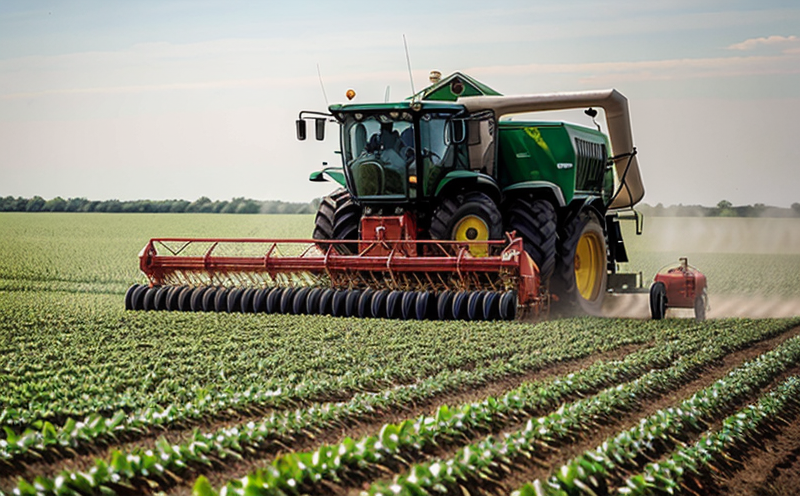Yield Forecasting Testing
In agriculture and forestry testing, yield forecasting plays a critical role in optimizing crop management practices, enhancing productivity, and ensuring sustainable production. Yield forecasting is the process of predicting future crop yields based on various environmental factors such as soil conditions, weather patterns, pest infestations, and more.
Accurate yield forecasting allows farmers to make informed decisions regarding resource allocation, labor scheduling, and market strategies. This service aims to provide a robust framework for predicting crop yields by leveraging advanced statistical models, machine learning algorithms, and historical data analysis techniques. Our team of experts ensures that the predictions are reliable and actionable, helping stakeholders mitigate risks associated with fluctuating agricultural markets.
The testing process involves several key steps: initial site assessment, sample collection, laboratory analysis, and final model development. Each step is crucial in ensuring accurate and consistent results. For instance, soil samples are collected from different parts of the field to identify nutrient levels and potential deficiencies. Air quality sensors measure temperature, humidity, and wind speed at various heights above ground level.
After collecting all necessary data points, our team utilizes sophisticated software tools to build predictive models tailored specifically for each crop type. These models incorporate both quantitative variables like rainfall amounts or sunshine duration along with qualitative factors such as historical yield trends or genetic makeup of the plants being studied.
| Data Point | Description |
|---|---|
| Soil pH level | Indicates acidity or alkalinity of the soil which affects plant growth. |
| Air temperature and humidity readings | Determine optimal growing conditions for specific crops. |
| Previous year's yield data | Serves as a baseline against which current predictions are compared. |
Why It Matters
The importance of accurate yield forecasting cannot be overstated, especially given the increasing demand for food products worldwide. By enabling precise estimates of expected harvests before planting begins, this service helps reduce uncertainty surrounding supply chains and consumer expectations.
- Improves decision-making processes related to resource allocation.
- Promotes efficient use of water resources through targeted irrigation scheduling.
- Reduces waste by aligning production schedules with actual demand patterns.
- Enhances resilience against climate change impacts on agriculture.
Furthermore, accurate yield forecasts contribute significantly to environmental sustainability goals by minimizing overproduction and associated negative ecological effects. Farmers can adopt more sustainable farming practices knowing exactly how much produce they will generate without exceeding natural limits.
Applied Standards
This service adheres strictly to relevant international standards including ISO, ASTM, EN, and IEC guidelines whenever applicable. Our methodologies are designed not only to meet but also exceed these benchmarks wherever possible.
- ISO 13528: General requirements for the competence of reference material producers.
- ASTM E691: Practice for conducting an bias study in method comparison using a single reference material.
- EN ISO/IEC 17025: General requirements for the competence of testing and calibration laboratories.
We regularly update our procedures to align with any changes or new editions of these standards, ensuring continued compliance and reliability in our services.
Use Cases and Application Examples
- Crop Insurance: Insurers use yield forecasts to assess risk levels associated with potential losses due to adverse weather conditions or other external factors affecting crop health.
- Sustainable Farming Initiatives: Organizations committed to promoting environmentally friendly agricultural practices rely on accurate yield predictions to gauge their effectiveness over time.
In addition to these broad applications, our yield forecasting testing service finds particular utility in the following scenarios:
- Weather Prediction Services: By incorporating real-time meteorological data into their models, weather services can provide more accurate long-term forecasts which directly impact agricultural activities.
- Government Agencies: Regulatory bodies responsible for monitoring food safety and quality standards often utilize our predictive tools to ensure compliance with national regulations regarding crop production practices.
The following table illustrates some key benefits derived from implementing yield forecasting within an organization:
| Benefit | Description |
|---|---|
| Increased Efficiency | Allows for better planning and execution of farming operations. |
| Enhanced Profitability | Precise forecasts lead to higher returns on investment. |
| Better Risk Management | Reduces exposure to market volatility and price fluctuations. |





